Analyzing the Relationship Between Culture and Health in Nursing
VerifiedAdded on 2022/09/14
|8
|1563
|16
Report
AI Summary
This report delves into the intricate relationship between culture and health, emphasizing how cultural factors influence healthcare delivery and patient outcomes. It highlights the impact of cultural biases, linguistic differences, and varying perceptions of health, illness, and death. The report underscores the importance of cultural adaptations in healthcare settings, such as providing interpreters and culturally sensitive care plans, especially when dealing with diverse patient populations like Aboriginal patients. It discusses the advantages of cultural diversity in the workplace and the necessity of cultural competence in nursing to ensure patient-centered care. Furthermore, the report examines strategies for promoting cultural safety through online platforms and media, advocating for discussions on topics such as nurse staffing diversity and the medicalization of health issues. The references include several scholarly articles and guidelines related to cultural competence and patient care.
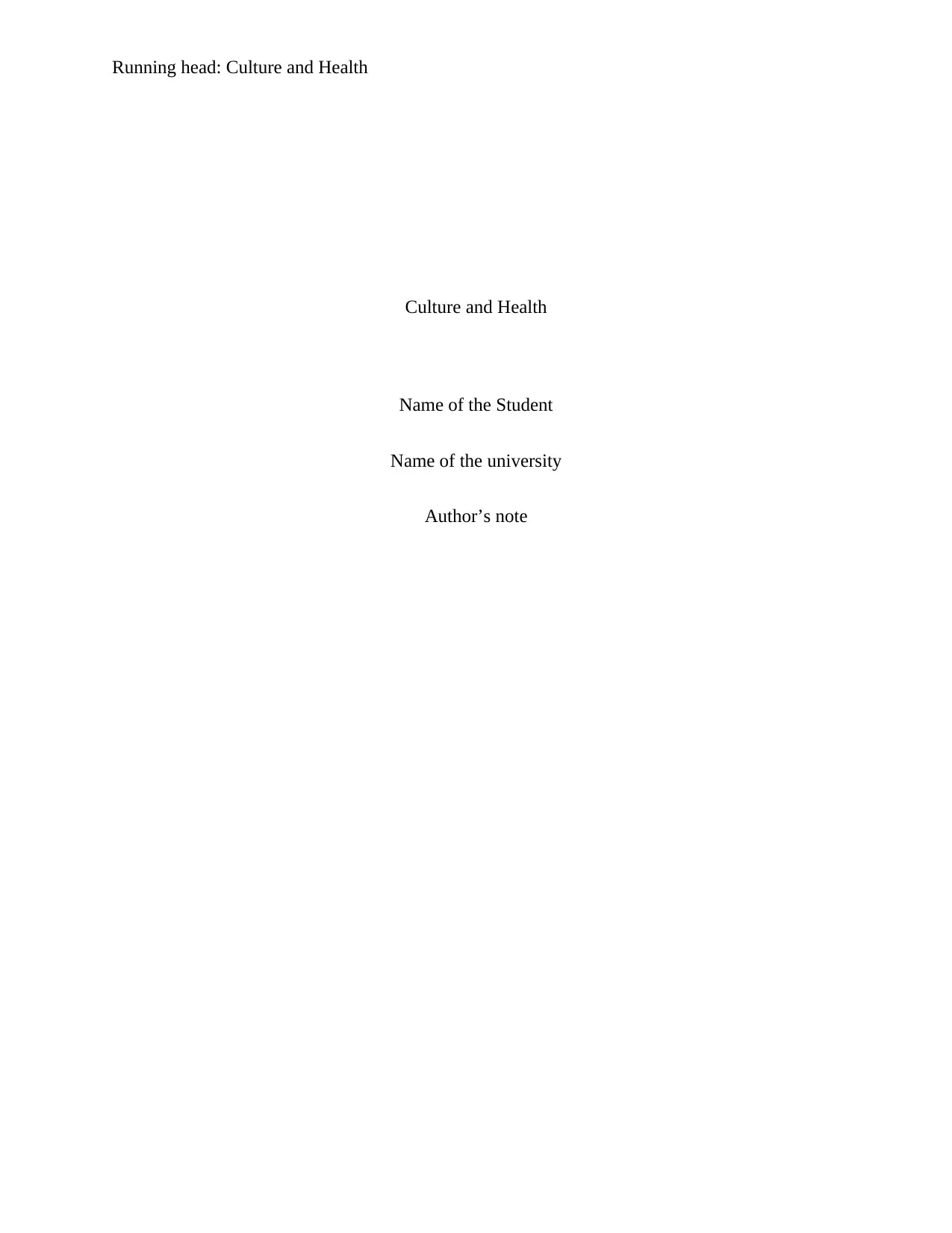
Running head: Culture and Health
Culture and Health
Name of the Student
Name of the university
Author’s note
Culture and Health
Name of the Student
Name of the university
Author’s note
Paraphrase This Document
Need a fresh take? Get an instant paraphrase of this document with our AI Paraphraser
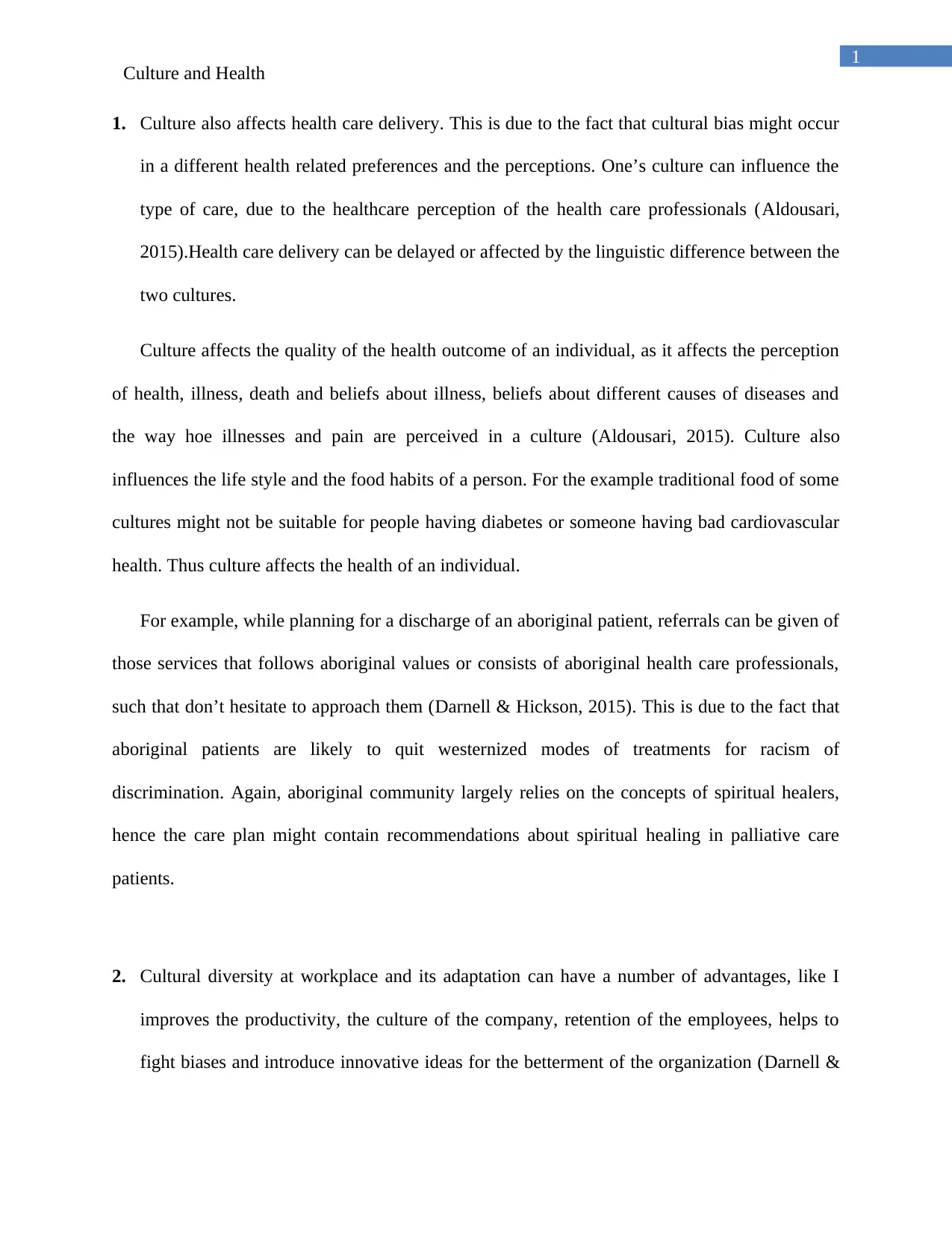
1
Culture and Health
1. Culture also affects health care delivery. This is due to the fact that cultural bias might occur
in a different health related preferences and the perceptions. One’s culture can influence the
type of care, due to the healthcare perception of the health care professionals (Aldousari,
2015).Health care delivery can be delayed or affected by the linguistic difference between the
two cultures.
Culture affects the quality of the health outcome of an individual, as it affects the perception
of health, illness, death and beliefs about illness, beliefs about different causes of diseases and
the way hoe illnesses and pain are perceived in a culture (Aldousari, 2015). Culture also
influences the life style and the food habits of a person. For the example traditional food of some
cultures might not be suitable for people having diabetes or someone having bad cardiovascular
health. Thus culture affects the health of an individual.
For example, while planning for a discharge of an aboriginal patient, referrals can be given of
those services that follows aboriginal values or consists of aboriginal health care professionals,
such that don’t hesitate to approach them (Darnell & Hickson, 2015). This is due to the fact that
aboriginal patients are likely to quit westernized modes of treatments for racism of
discrimination. Again, aboriginal community largely relies on the concepts of spiritual healers,
hence the care plan might contain recommendations about spiritual healing in palliative care
patients.
2. Cultural diversity at workplace and its adaptation can have a number of advantages, like I
improves the productivity, the culture of the company, retention of the employees, helps to
fight biases and introduce innovative ideas for the betterment of the organization (Darnell &
Culture and Health
1. Culture also affects health care delivery. This is due to the fact that cultural bias might occur
in a different health related preferences and the perceptions. One’s culture can influence the
type of care, due to the healthcare perception of the health care professionals (Aldousari,
2015).Health care delivery can be delayed or affected by the linguistic difference between the
two cultures.
Culture affects the quality of the health outcome of an individual, as it affects the perception
of health, illness, death and beliefs about illness, beliefs about different causes of diseases and
the way hoe illnesses and pain are perceived in a culture (Aldousari, 2015). Culture also
influences the life style and the food habits of a person. For the example traditional food of some
cultures might not be suitable for people having diabetes or someone having bad cardiovascular
health. Thus culture affects the health of an individual.
For example, while planning for a discharge of an aboriginal patient, referrals can be given of
those services that follows aboriginal values or consists of aboriginal health care professionals,
such that don’t hesitate to approach them (Darnell & Hickson, 2015). This is due to the fact that
aboriginal patients are likely to quit westernized modes of treatments for racism of
discrimination. Again, aboriginal community largely relies on the concepts of spiritual healers,
hence the care plan might contain recommendations about spiritual healing in palliative care
patients.
2. Cultural diversity at workplace and its adaptation can have a number of advantages, like I
improves the productivity, the culture of the company, retention of the employees, helps to
fight biases and introduce innovative ideas for the betterment of the organization (Darnell &
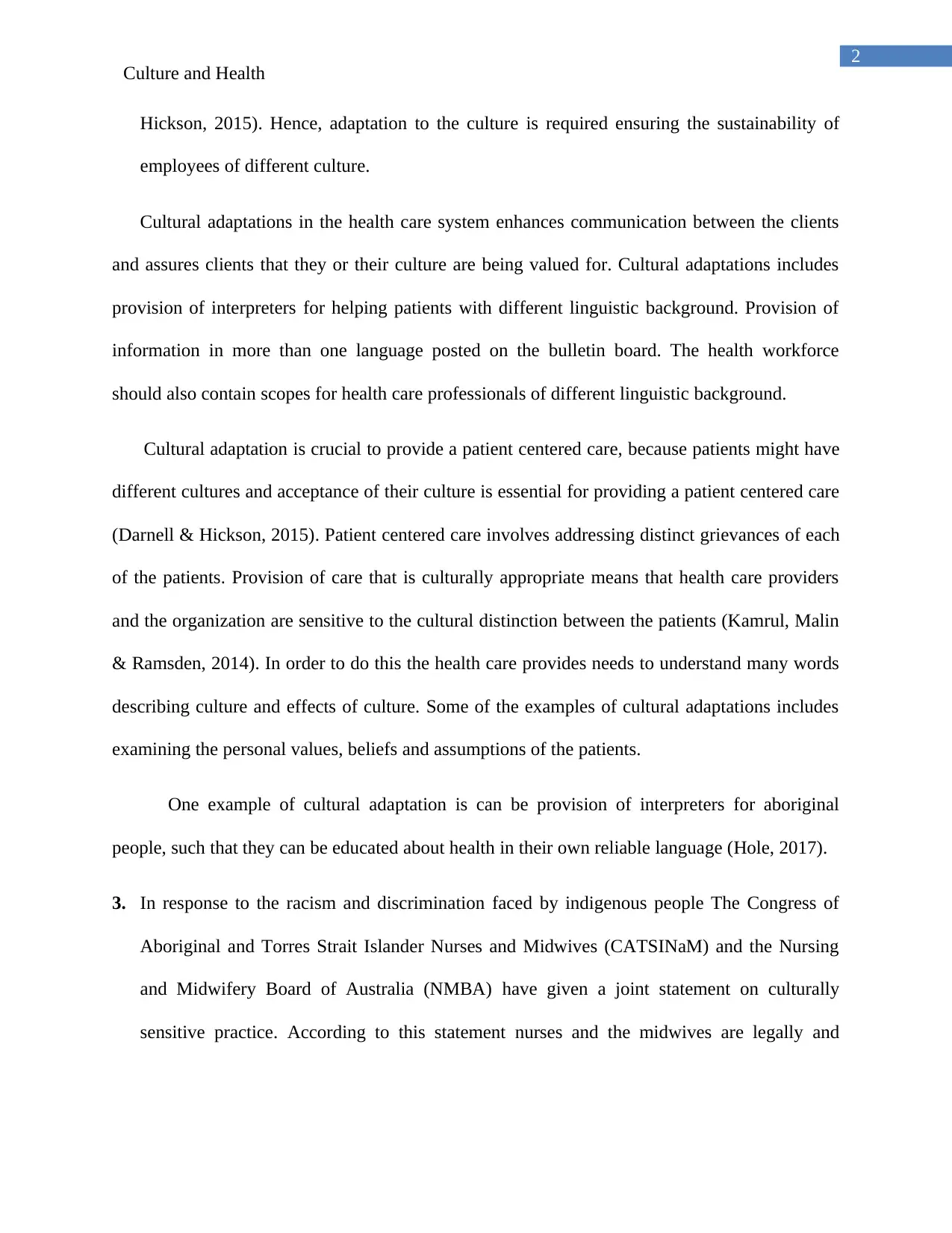
2
Culture and Health
Hickson, 2015). Hence, adaptation to the culture is required ensuring the sustainability of
employees of different culture.
Cultural adaptations in the health care system enhances communication between the clients
and assures clients that they or their culture are being valued for. Cultural adaptations includes
provision of interpreters for helping patients with different linguistic background. Provision of
information in more than one language posted on the bulletin board. The health workforce
should also contain scopes for health care professionals of different linguistic background.
Cultural adaptation is crucial to provide a patient centered care, because patients might have
different cultures and acceptance of their culture is essential for providing a patient centered care
(Darnell & Hickson, 2015). Patient centered care involves addressing distinct grievances of each
of the patients. Provision of care that is culturally appropriate means that health care providers
and the organization are sensitive to the cultural distinction between the patients (Kamrul, Malin
& Ramsden, 2014). In order to do this the health care provides needs to understand many words
describing culture and effects of culture. Some of the examples of cultural adaptations includes
examining the personal values, beliefs and assumptions of the patients.
One example of cultural adaptation is can be provision of interpreters for aboriginal
people, such that they can be educated about health in their own reliable language (Hole, 2017).
3. In response to the racism and discrimination faced by indigenous people The Congress of
Aboriginal and Torres Strait Islander Nurses and Midwives (CATSINaM) and the Nursing
and Midwifery Board of Australia (NMBA) have given a joint statement on culturally
sensitive practice. According to this statement nurses and the midwives are legally and
Culture and Health
Hickson, 2015). Hence, adaptation to the culture is required ensuring the sustainability of
employees of different culture.
Cultural adaptations in the health care system enhances communication between the clients
and assures clients that they or their culture are being valued for. Cultural adaptations includes
provision of interpreters for helping patients with different linguistic background. Provision of
information in more than one language posted on the bulletin board. The health workforce
should also contain scopes for health care professionals of different linguistic background.
Cultural adaptation is crucial to provide a patient centered care, because patients might have
different cultures and acceptance of their culture is essential for providing a patient centered care
(Darnell & Hickson, 2015). Patient centered care involves addressing distinct grievances of each
of the patients. Provision of care that is culturally appropriate means that health care providers
and the organization are sensitive to the cultural distinction between the patients (Kamrul, Malin
& Ramsden, 2014). In order to do this the health care provides needs to understand many words
describing culture and effects of culture. Some of the examples of cultural adaptations includes
examining the personal values, beliefs and assumptions of the patients.
One example of cultural adaptation is can be provision of interpreters for aboriginal
people, such that they can be educated about health in their own reliable language (Hole, 2017).
3. In response to the racism and discrimination faced by indigenous people The Congress of
Aboriginal and Torres Strait Islander Nurses and Midwives (CATSINaM) and the Nursing
and Midwifery Board of Australia (NMBA) have given a joint statement on culturally
sensitive practice. According to this statement nurses and the midwives are legally and
⊘ This is a preview!⊘
Do you want full access?
Subscribe today to unlock all pages.

Trusted by 1+ million students worldwide
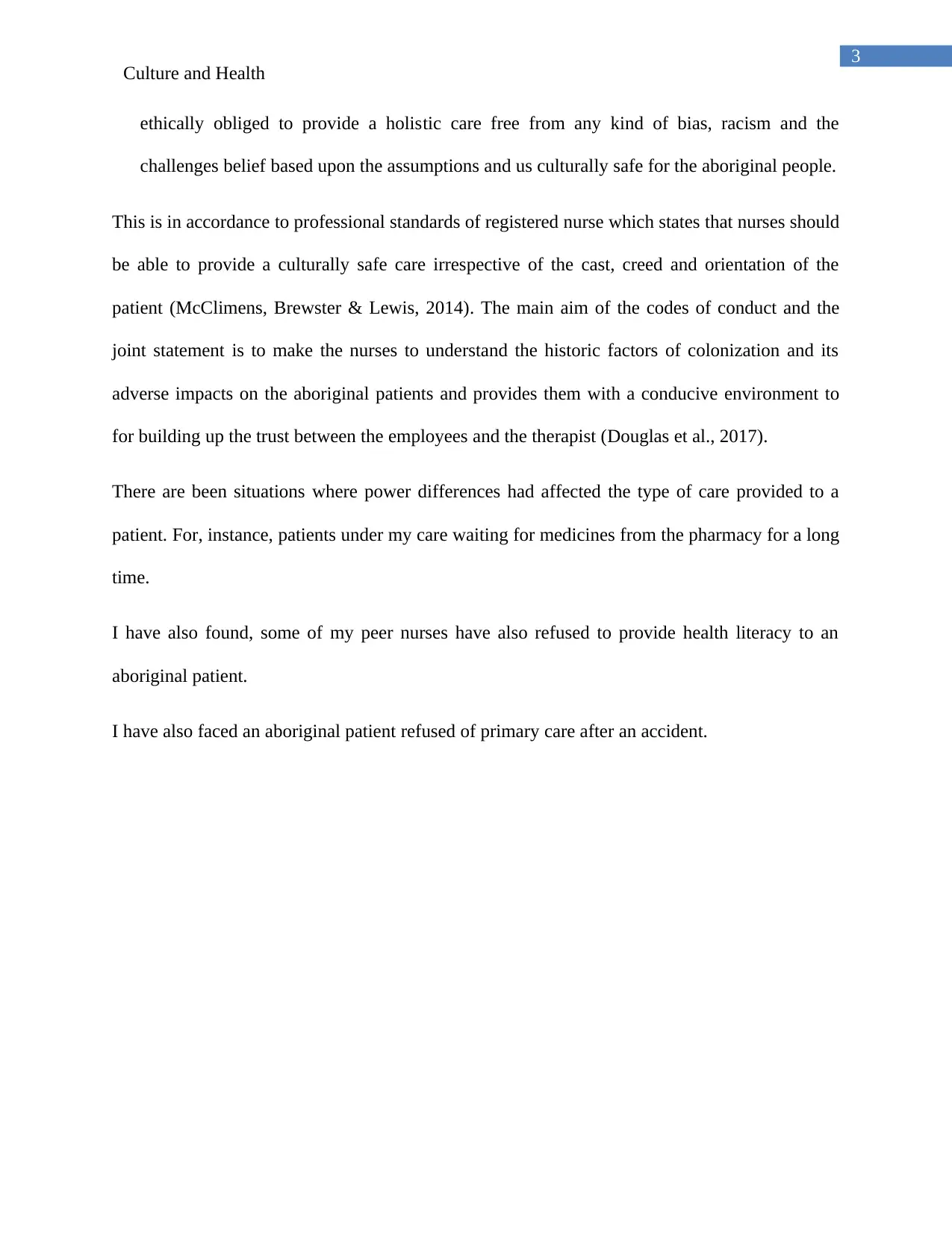
3
Culture and Health
ethically obliged to provide a holistic care free from any kind of bias, racism and the
challenges belief based upon the assumptions and us culturally safe for the aboriginal people.
This is in accordance to professional standards of registered nurse which states that nurses should
be able to provide a culturally safe care irrespective of the cast, creed and orientation of the
patient (McClimens, Brewster & Lewis, 2014). The main aim of the codes of conduct and the
joint statement is to make the nurses to understand the historic factors of colonization and its
adverse impacts on the aboriginal patients and provides them with a conducive environment to
for building up the trust between the employees and the therapist (Douglas et al., 2017).
There are been situations where power differences had affected the type of care provided to a
patient. For, instance, patients under my care waiting for medicines from the pharmacy for a long
time.
I have also found, some of my peer nurses have also refused to provide health literacy to an
aboriginal patient.
I have also faced an aboriginal patient refused of primary care after an accident.
Culture and Health
ethically obliged to provide a holistic care free from any kind of bias, racism and the
challenges belief based upon the assumptions and us culturally safe for the aboriginal people.
This is in accordance to professional standards of registered nurse which states that nurses should
be able to provide a culturally safe care irrespective of the cast, creed and orientation of the
patient (McClimens, Brewster & Lewis, 2014). The main aim of the codes of conduct and the
joint statement is to make the nurses to understand the historic factors of colonization and its
adverse impacts on the aboriginal patients and provides them with a conducive environment to
for building up the trust between the employees and the therapist (Douglas et al., 2017).
There are been situations where power differences had affected the type of care provided to a
patient. For, instance, patients under my care waiting for medicines from the pharmacy for a long
time.
I have also found, some of my peer nurses have also refused to provide health literacy to an
aboriginal patient.
I have also faced an aboriginal patient refused of primary care after an accident.
Paraphrase This Document
Need a fresh take? Get an instant paraphrase of this document with our AI Paraphraser
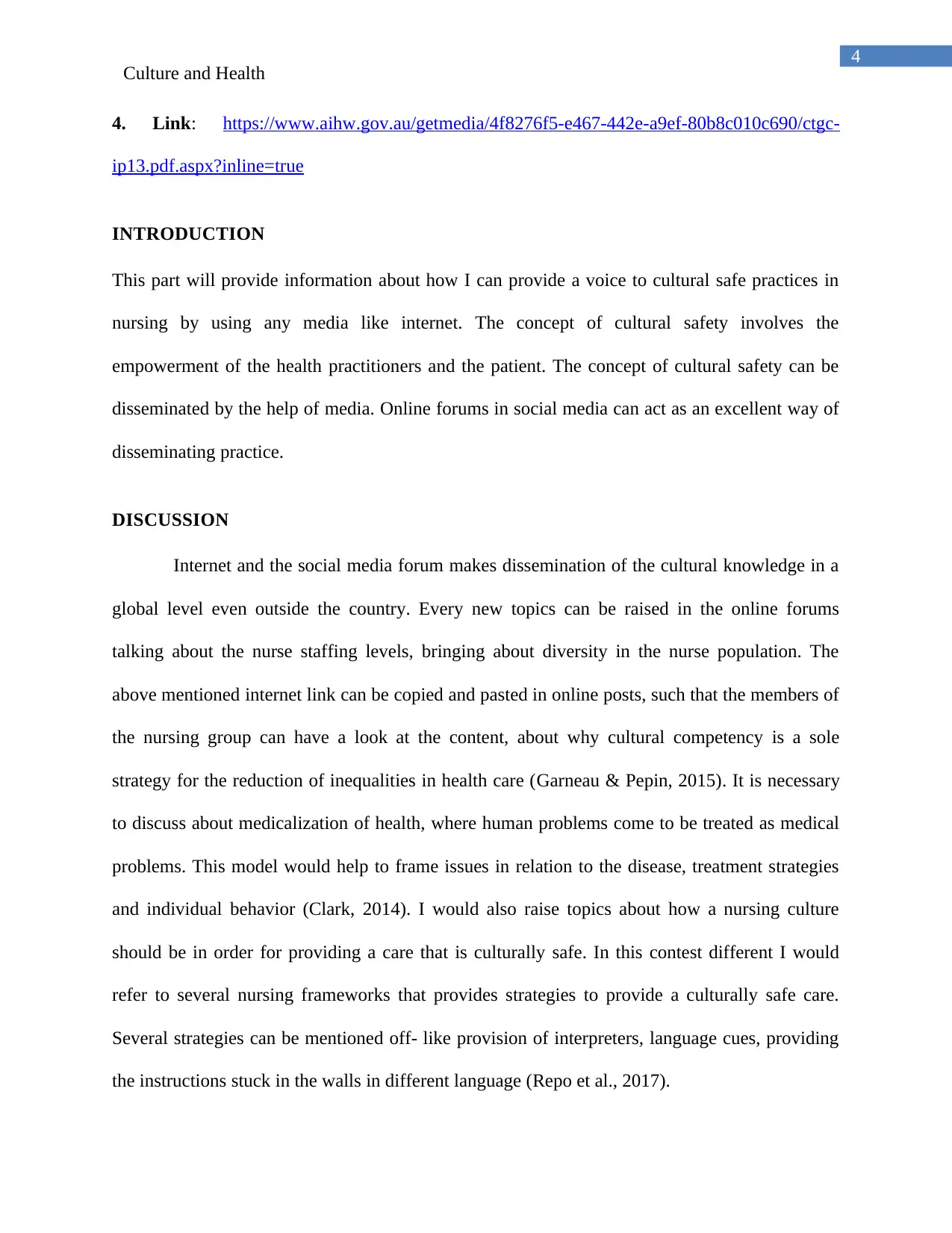
4
Culture and Health
4. Link: https://www.aihw.gov.au/getmedia/4f8276f5-e467-442e-a9ef-80b8c010c690/ctgc-
ip13.pdf.aspx?inline=true
INTRODUCTION
This part will provide information about how I can provide a voice to cultural safe practices in
nursing by using any media like internet. The concept of cultural safety involves the
empowerment of the health practitioners and the patient. The concept of cultural safety can be
disseminated by the help of media. Online forums in social media can act as an excellent way of
disseminating practice.
DISCUSSION
Internet and the social media forum makes dissemination of the cultural knowledge in a
global level even outside the country. Every new topics can be raised in the online forums
talking about the nurse staffing levels, bringing about diversity in the nurse population. The
above mentioned internet link can be copied and pasted in online posts, such that the members of
the nursing group can have a look at the content, about why cultural competency is a sole
strategy for the reduction of inequalities in health care (Garneau & Pepin, 2015). It is necessary
to discuss about medicalization of health, where human problems come to be treated as medical
problems. This model would help to frame issues in relation to the disease, treatment strategies
and individual behavior (Clark, 2014). I would also raise topics about how a nursing culture
should be in order for providing a care that is culturally safe. In this contest different I would
refer to several nursing frameworks that provides strategies to provide a culturally safe care.
Several strategies can be mentioned off- like provision of interpreters, language cues, providing
the instructions stuck in the walls in different language (Repo et al., 2017).
Culture and Health
4. Link: https://www.aihw.gov.au/getmedia/4f8276f5-e467-442e-a9ef-80b8c010c690/ctgc-
ip13.pdf.aspx?inline=true
INTRODUCTION
This part will provide information about how I can provide a voice to cultural safe practices in
nursing by using any media like internet. The concept of cultural safety involves the
empowerment of the health practitioners and the patient. The concept of cultural safety can be
disseminated by the help of media. Online forums in social media can act as an excellent way of
disseminating practice.
DISCUSSION
Internet and the social media forum makes dissemination of the cultural knowledge in a
global level even outside the country. Every new topics can be raised in the online forums
talking about the nurse staffing levels, bringing about diversity in the nurse population. The
above mentioned internet link can be copied and pasted in online posts, such that the members of
the nursing group can have a look at the content, about why cultural competency is a sole
strategy for the reduction of inequalities in health care (Garneau & Pepin, 2015). It is necessary
to discuss about medicalization of health, where human problems come to be treated as medical
problems. This model would help to frame issues in relation to the disease, treatment strategies
and individual behavior (Clark, 2014). I would also raise topics about how a nursing culture
should be in order for providing a care that is culturally safe. In this contest different I would
refer to several nursing frameworks that provides strategies to provide a culturally safe care.
Several strategies can be mentioned off- like provision of interpreters, language cues, providing
the instructions stuck in the walls in different language (Repo et al., 2017).
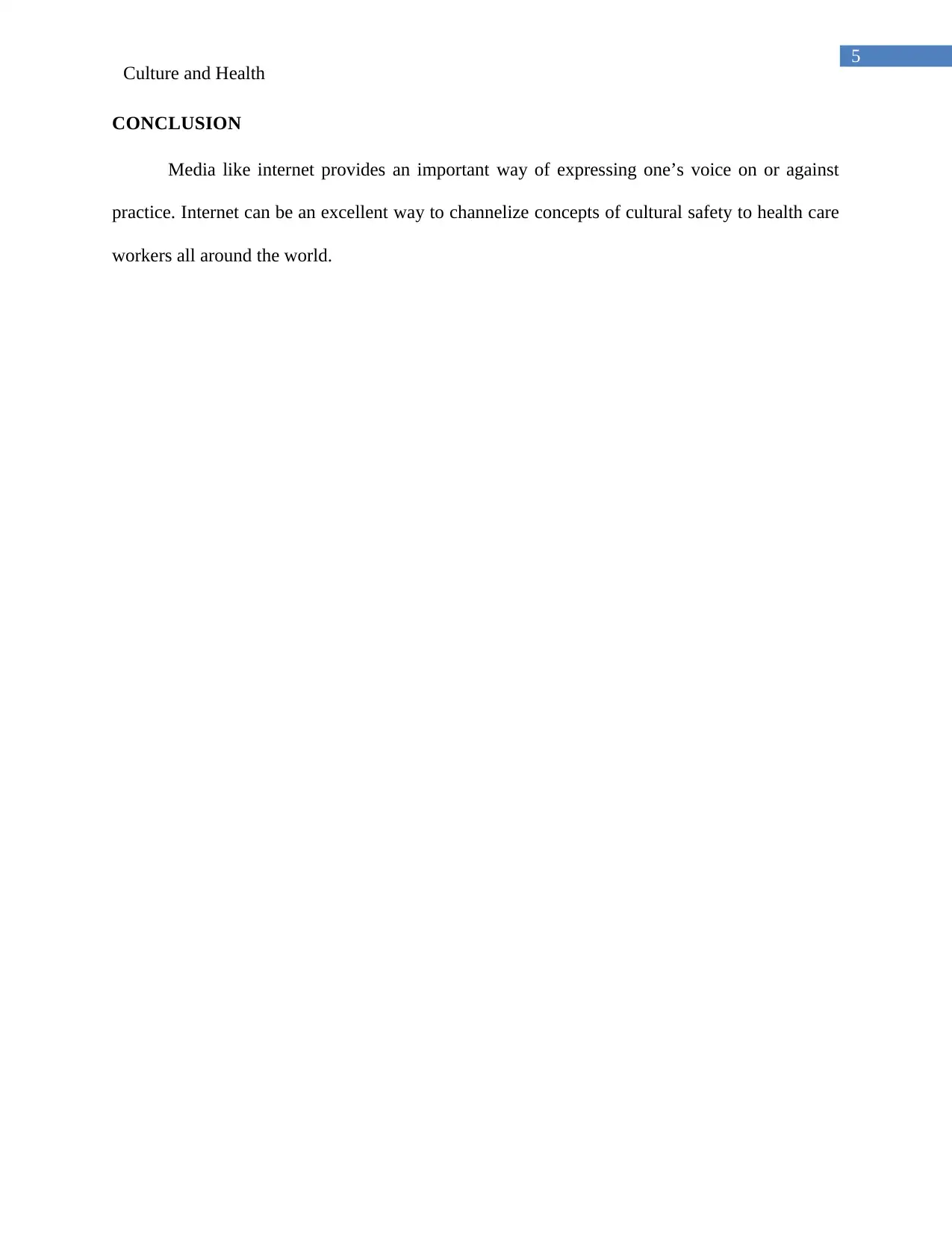
5
Culture and Health
CONCLUSION
Media like internet provides an important way of expressing one’s voice on or against
practice. Internet can be an excellent way to channelize concepts of cultural safety to health care
workers all around the world.
Culture and Health
CONCLUSION
Media like internet provides an important way of expressing one’s voice on or against
practice. Internet can be an excellent way to channelize concepts of cultural safety to health care
workers all around the world.
⊘ This is a preview!⊘
Do you want full access?
Subscribe today to unlock all pages.

Trusted by 1+ million students worldwide
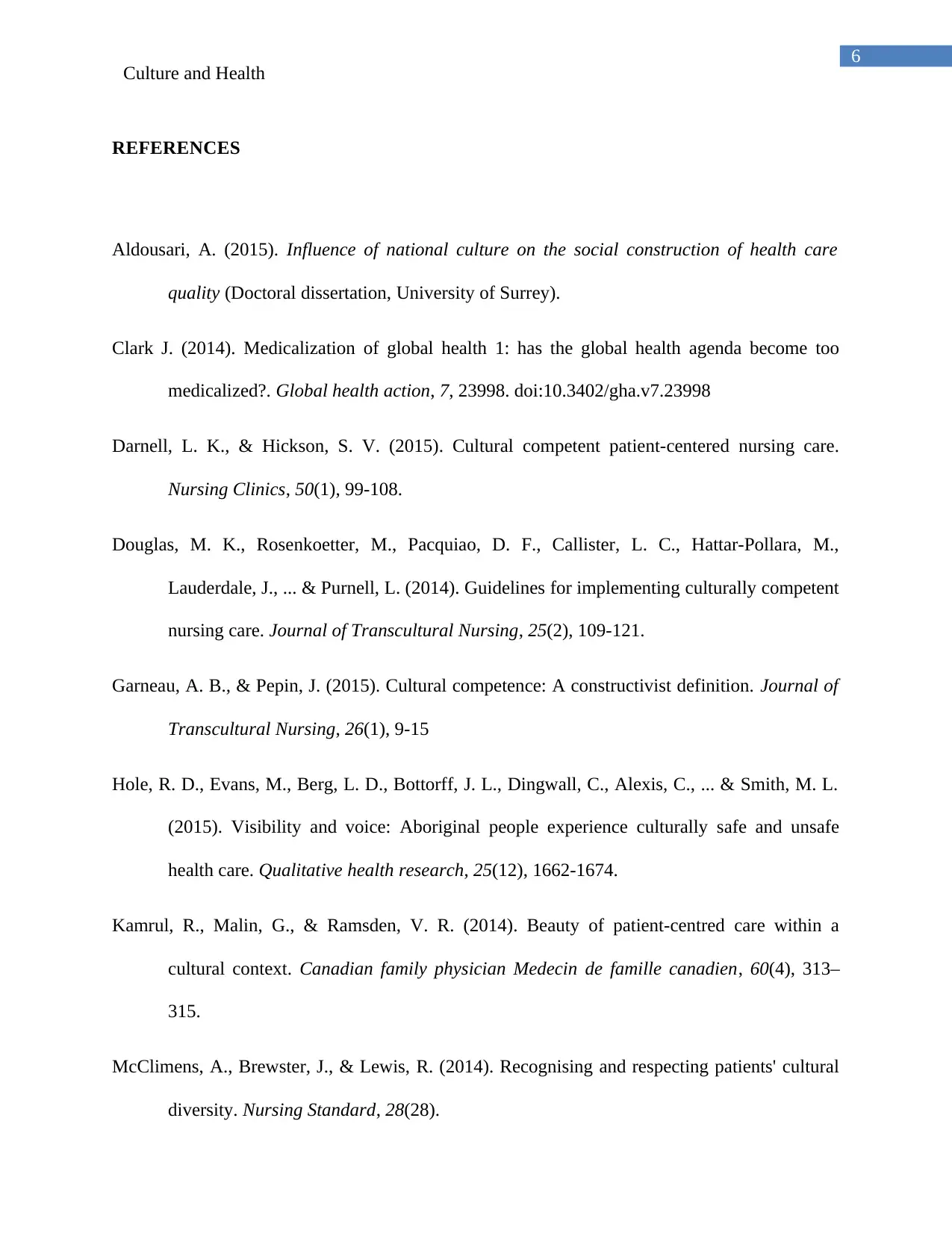
6
Culture and Health
REFERENCES
Aldousari, A. (2015). Influence of national culture on the social construction of health care
quality (Doctoral dissertation, University of Surrey).
Clark J. (2014). Medicalization of global health 1: has the global health agenda become too
medicalized?. Global health action, 7, 23998. doi:10.3402/gha.v7.23998
Darnell, L. K., & Hickson, S. V. (2015). Cultural competent patient-centered nursing care.
Nursing Clinics, 50(1), 99-108.
Douglas, M. K., Rosenkoetter, M., Pacquiao, D. F., Callister, L. C., Hattar-Pollara, M.,
Lauderdale, J., ... & Purnell, L. (2014). Guidelines for implementing culturally competent
nursing care. Journal of Transcultural Nursing, 25(2), 109-121.
Garneau, A. B., & Pepin, J. (2015). Cultural competence: A constructivist definition. Journal of
Transcultural Nursing, 26(1), 9-15
Hole, R. D., Evans, M., Berg, L. D., Bottorff, J. L., Dingwall, C., Alexis, C., ... & Smith, M. L.
(2015). Visibility and voice: Aboriginal people experience culturally safe and unsafe
health care. Qualitative health research, 25(12), 1662-1674.
Kamrul, R., Malin, G., & Ramsden, V. R. (2014). Beauty of patient-centred care within a
cultural context. Canadian family physician Medecin de famille canadien, 60(4), 313–
315.
McClimens, A., Brewster, J., & Lewis, R. (2014). Recognising and respecting patients' cultural
diversity. Nursing Standard, 28(28).
Culture and Health
REFERENCES
Aldousari, A. (2015). Influence of national culture on the social construction of health care
quality (Doctoral dissertation, University of Surrey).
Clark J. (2014). Medicalization of global health 1: has the global health agenda become too
medicalized?. Global health action, 7, 23998. doi:10.3402/gha.v7.23998
Darnell, L. K., & Hickson, S. V. (2015). Cultural competent patient-centered nursing care.
Nursing Clinics, 50(1), 99-108.
Douglas, M. K., Rosenkoetter, M., Pacquiao, D. F., Callister, L. C., Hattar-Pollara, M.,
Lauderdale, J., ... & Purnell, L. (2014). Guidelines for implementing culturally competent
nursing care. Journal of Transcultural Nursing, 25(2), 109-121.
Garneau, A. B., & Pepin, J. (2015). Cultural competence: A constructivist definition. Journal of
Transcultural Nursing, 26(1), 9-15
Hole, R. D., Evans, M., Berg, L. D., Bottorff, J. L., Dingwall, C., Alexis, C., ... & Smith, M. L.
(2015). Visibility and voice: Aboriginal people experience culturally safe and unsafe
health care. Qualitative health research, 25(12), 1662-1674.
Kamrul, R., Malin, G., & Ramsden, V. R. (2014). Beauty of patient-centred care within a
cultural context. Canadian family physician Medecin de famille canadien, 60(4), 313–
315.
McClimens, A., Brewster, J., & Lewis, R. (2014). Recognising and respecting patients' cultural
diversity. Nursing Standard, 28(28).
Paraphrase This Document
Need a fresh take? Get an instant paraphrase of this document with our AI Paraphraser
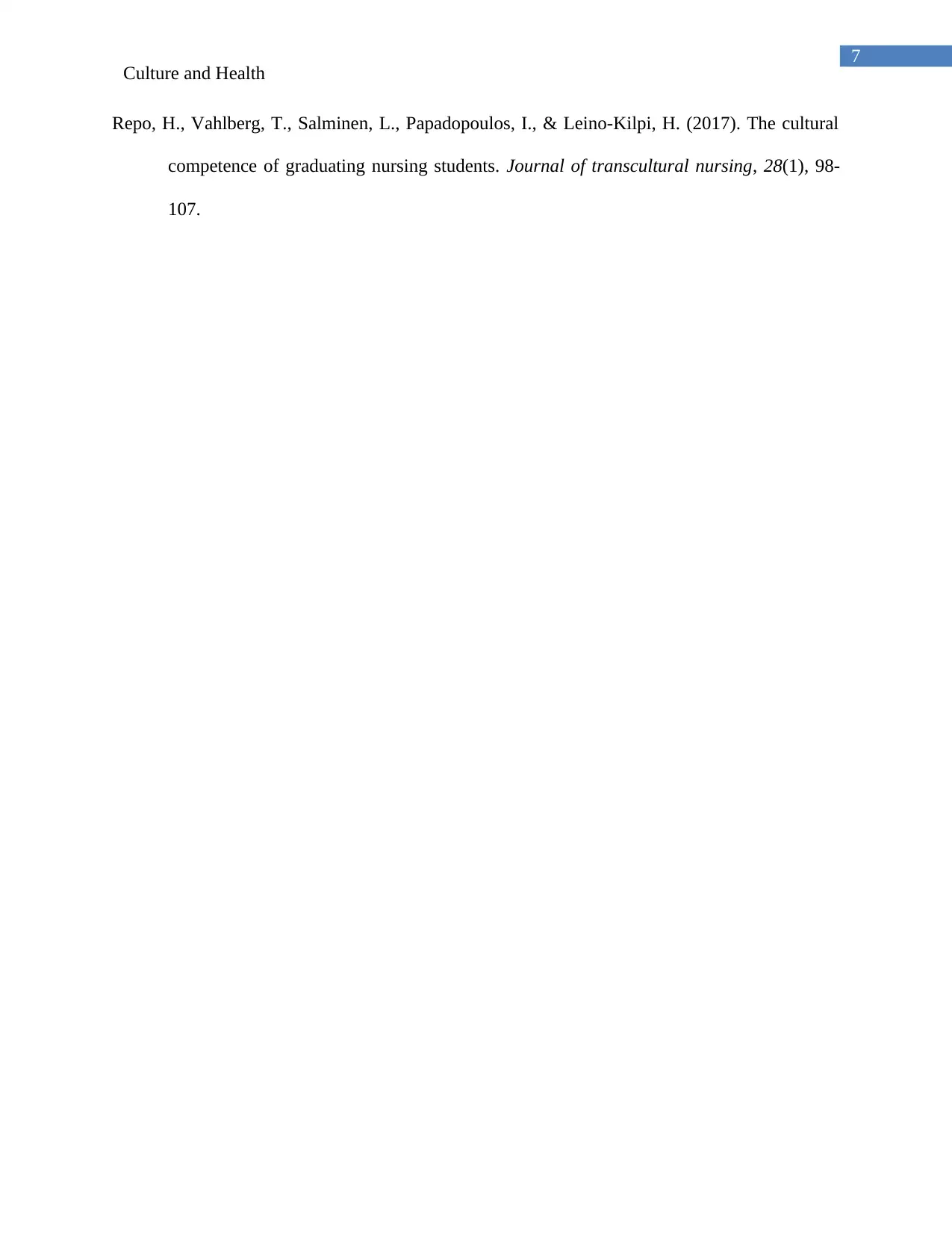
7
Culture and Health
Repo, H., Vahlberg, T., Salminen, L., Papadopoulos, I., & Leino-Kilpi, H. (2017). The cultural
competence of graduating nursing students. Journal of transcultural nursing, 28(1), 98-
107.
Culture and Health
Repo, H., Vahlberg, T., Salminen, L., Papadopoulos, I., & Leino-Kilpi, H. (2017). The cultural
competence of graduating nursing students. Journal of transcultural nursing, 28(1), 98-
107.
1 out of 8
Related Documents
Your All-in-One AI-Powered Toolkit for Academic Success.
+13062052269
info@desklib.com
Available 24*7 on WhatsApp / Email
![[object Object]](/_next/static/media/star-bottom.7253800d.svg)
Unlock your academic potential
Copyright © 2020–2025 A2Z Services. All Rights Reserved. Developed and managed by ZUCOL.





